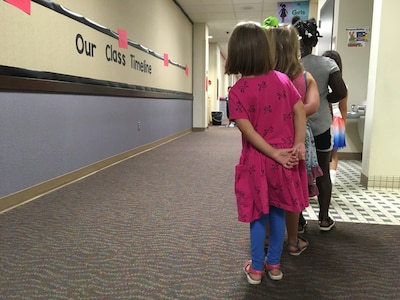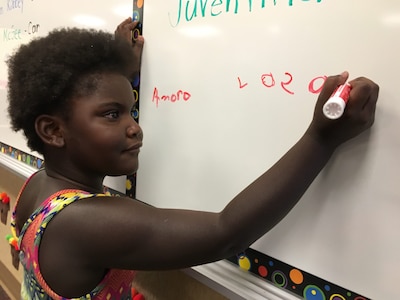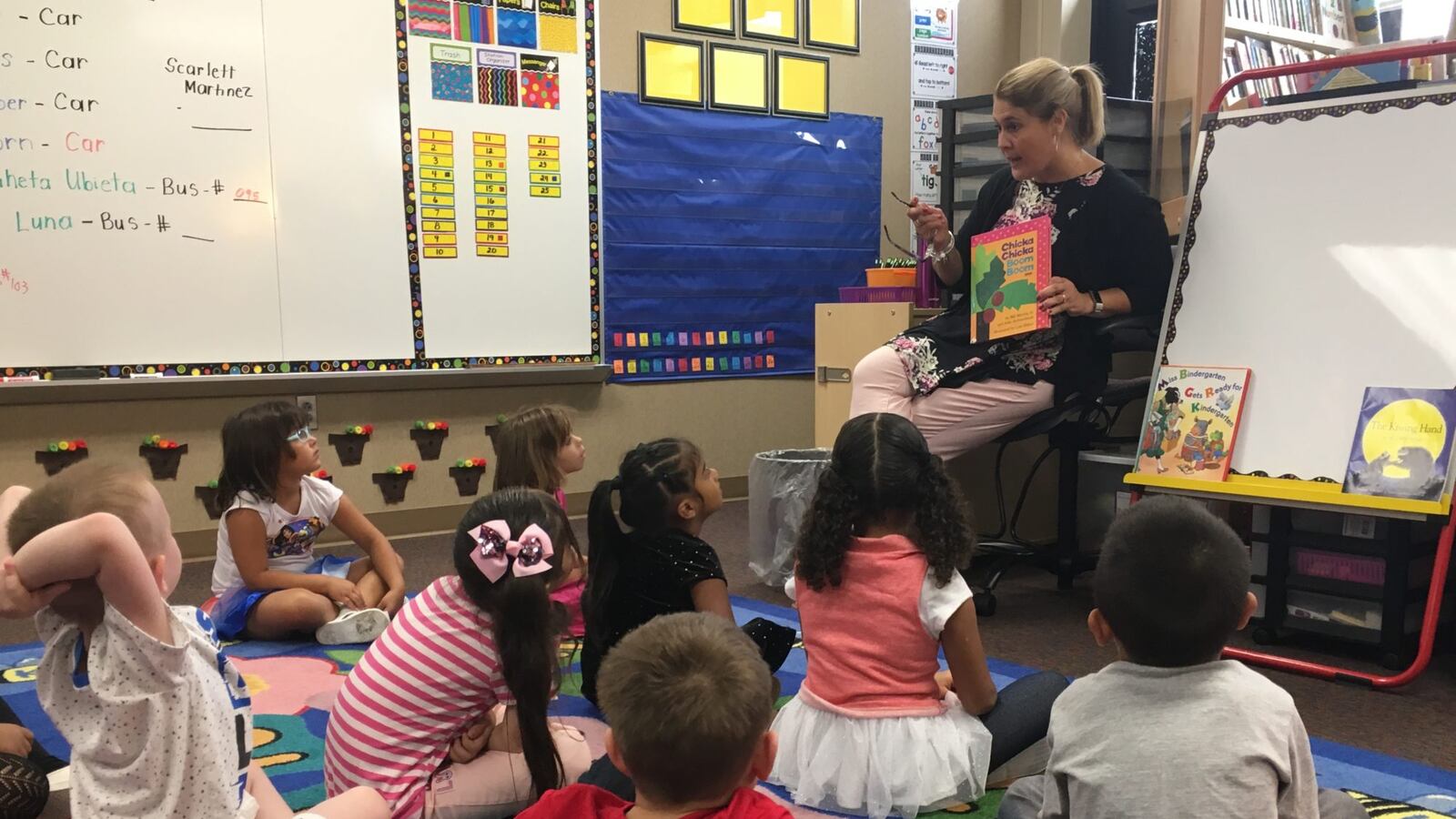On the first day of school Thursday, 5-year-olds trickled into Mandy Sequin’s kindergarten class at Stout Field Elementary School on the westside of Indianapolis.
Some children had just stepped off the school bus for the first time, toting backpacks. Others said goodbye to teary parents who dropped them off. One little boy was crying, and many of his classmates seemed to be taking in the newness of the whole situation with awe and apprehension.
Ready or not, here they were.
Already, some of the 5-year-olds are ahead of the others. In Sequin’s class of 17 — it will likely grow throughout the year, as more students enroll — at least eight attended preschool, which educators and researchers say gives them an edge in school.
In the growing conversation about expanding early learning opportunities in Indiana, a central question is: Is preschool worth it? As policymakers consider the outcomes of limited city and state pre-Kindergarten programs, many want to see proof of how well preschool prepares children for kindergarten. Some remain skeptical of the gains, even as early childhood education advocates point to studies showing the benefit of preschool many years on.
But with 18 years of teaching experience, Sequin says she often can clearly see the differences between preschool graduates and those who didn’t go to preschool, as soon as they come into the classroom.
“The first thing it helps with is learning school, so we don’t have to spend as much time on that,” Sequin said, explaining that preschool graduates often already understand how classrooms work and how they’re supposed to behave. “We can jump right into the academic part of it. And then also, it helps get them further.”
Children may get a head start on academics in preschool, but the behavioral piece — knowing how to transition into the classroom — is the greatest advantage that preschoolers have, said Michael Conn-Powers, director of the Early Childhood Center at the Indiana Institute on Disability and Community.
“We’ll teach them to read, we’ll teach them the math and the science — but children have to have the social-emotional skills to know how to sit and pay attention and follow the rules, and be able to take turns and take care of themselves,” he said.

As the first few students settled into Sequin’s classroom Thursday morning, they followed her instructions to pick a chair and hang their backpacks on it. Two former preschoolers took her directions to sit on the carpet in the middle of the room to watch “Daniel Tiger” cartoons.
A boy who didn’t go to preschool sat down, then got up. He wandered to the classroom’s book corner, then went back to his seat and put on his backpack. Sequin reminded him twice to sit down. He asked to use the bathroom. He clapped his hands. He lifted up his shirt. He chattered to himself.
It may have just been first-day nerves, but throughout the morning, he struggled to sit still and pay attention to instructions. Sequin, who knows she will have to teach some students basic behavioral expectations from scratch, redirected him gently.
Good preschools can teach young students how to adapt to new settings, a valuable lesson that Conn-Powers said children can’t get at home or in unstructured preschools.
“It’s not like a child is automatically penalized if they didn’t go to preschool, but there might be a transition period where they are getting used to being in a group of 20 kids, and learning to have to follow the guidelines and the rules and the expectations of a brand-new adult, who’s a stranger,” he said.
Still, educators acknowledge that going to preschool doesn’t always result in a more ready child with better long-term gains, and in turn, not going to preschool doesn’t count a child out. And children will grow at their own paces throughout kindergarten.
Sequin’s class reflects that mix: Two boys who didn’t have preschool experience wanted to speak up when they were supposed to be quiet — but so did a boy who went to preschool, raising his hand to interrupt Sequin while she was talking to the class.
“Can I tell you something?” the boy said. “I don’t know how to count to 100.”
“It’s a good thing you’re here, because we’re going to learn that this year!” Sequin told him.
One of the boys who went to preschool looked bewildered, but sat with two other students he knew from last year. Another boy who went to preschool stayed quiet and wouldn’t stand when the rest of the class was dancing to a song about movement. But he helped clean up the classroom after breakfast when Sequin looked to him as a helper.
In contrast, Macee McGee, a girl who didn’t go to preschool, was talkative and engaged. She pointed to the number 3 and spotted her name on a wall. She seamlessly blended in during reading time and when it was time to walk quietly through the hall.
Naturally inquisitive, she had been working on reading skills at home with her big sister, Macee’s grandfather Clarence McGee said.
“She knows what to expect,” he said.

But some children need more of a push. Amora Lasan’s parents enrolled her in preschool because they were worried when it took her a long time to start talking, and she wasn’t understanding numbers easily.
“We wanted her to get an early start,” said her father, Allen Lasan. “A lot of people wait until kindergarten.”
Amora graduated from preschool knowing how to write her first and last names with proper capitalization, a skill that kindergartners are expected to master by the end of the year.
Like several others in her class, Amora went to preschool last year at Stout Field Elementary, a full-day program for about 20 students, targeted at low-income families and accepted based on need, said Principal Tim Wickard. Overall, about 86 percent of students throughout the school last year came from lower-income families, according to state data.
Some of her kindergarten classmates attended Wayne Township’s preschool programs, which include developmental preschool for students with special needs.
But access to quality preschool remains limited. Early learning advocates say there aren’t enough high-quality preschool options, public or private, and they estimate tens of thousands of Hoosier children from low-income families still lack access to preschool.
The state recently launched a need-based pilot program for pre-Kindergarten, serving about 4,000 4-year-olds across 20 counties. Indianapolis has a similar, complementary program that also includes 3-year-olds.
Experts say preschool has proved to be beneficial especially for children of color, children with disabilities, and children learning English as a new language — helping those who are less ready for school to become more ready. Some of the gains come simply from more exposure to school concepts, like literacy. It’s an early intervention and investment that educators hope can mitigate the need for remediation and reduce suspensions down the road.
For many educators, there’s no question that early childhood education is effective. Conn-Powers said the real question lies in quality — the strength of a program’s curriculum to support social-emotional and academic development.
If schools don’t see increased kindergarten readiness, it doesn’t mean preschool “didn’t work,” he said. “It means somewhere along the way, we’ve left something out. We’ve cut corners. We made some mistakes, and so the quality of our preschools are lacking.”

